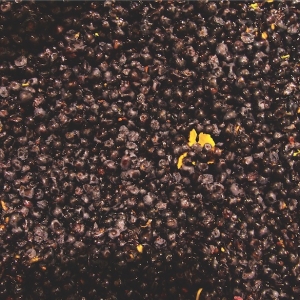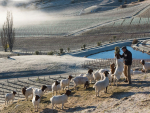But are these two opposing facts – low quantity, high quality – linked?
The answer arose when talking with Phyll Pattie from Ata Rangi Vineyard at the Pinot Noir 2013 conference in Wellington. She has long noticed the inverse relationship between Martinborough’s planted area – the Wairarapa has approximately 2.7% of New Zealand’s total vineyard – and the volume of its production; about one per cent, give or take vintage variation.
What causes this inverse statistic?
“It’s all about the region’s exposure to the south. The only other wine region which is regularly on the receiving end of that direct southerly weather in New Zealand is probably Waipara,” suggests Pattie.
“We get very cold nights because of the ocean influence and often we get frosts with the southerlies dumping unseasonal snow on our mountains. The southerly winds we often get during spring impacts on flowering,” she says.
The impact of this weather system is pivotal to the style of the wines from the region.
Its best wines consistently show a marked concentration in tannin levels which stamps the style of its Pinot Noirs.
The wines are an expression of the chilly spring weather, says Pattie. She is not alone in her belief. Other winemakers I have spoken to also see a direct correlation between chilly springs, high winds and tricky fruit set (something which frequently used to wipe out Neil McCallum’s Gewurztraminer grapes when he owned Dry River Wines; this meant that in some years he simply didn’t make one).
“We seem to get much lower yields than Pinot Noir producers in some other regions, which is backed up anecdotally by conversations we’ve had over the years with winemakers and growers in other regions,” says Pattie.
Many berries are not fertilised during flowering in spring, so consequently there are fewer berries per bunch.
Ultimately, the bunch weights in this region are relatively light and noticeably sparse, says Ata Rangi winemaker Helen Masters.
Masters first arrived in the region to work at Martinborough Vineyard in 2001 and later joined Ata Rangi at the end of 2003; prior to which she was a self-described gypsy; working in California and Oregon.
She believes the cool spring, the sparse and small bunches and the high ratio of tannins to pulp in Martinborough have a direct impact on the concentration of flavour in the region’s wines. Not only in Martinborough, but further afield in the greater Wairarapa too, she says.
“It would be interesting to do a photographic picture of a year in the region; looking at the same clones would tell you quite a bit of the story as to why the wines are this way,” she says.
“The ratio of pulp to skin means that there’s more tannin; Martinborough has a high level of seed tannin because the berries are small, and our season tends to be slightly longer and more drawn out in autumn,” she says.
“If you were to collect a whole line-up of Pinot Noir clones from Martinborough and lay them all out on a white sheet then put them next to the same clones from Marlborough or Central Otago, you would see big differences. And the biggest one, to me, is that our bunch weights in Martinborough are determined by a strong difference in flowering weather. Bunch sizes are significantly reduced because of this,” she says.
“I don’t see much over 110 grams, which is nearly half that of Central Otago. In a terrible year we might see a Dijon clone here which would be only 65 grams.”
Both Masters and Martinborough Vineyards winemaker Paul Mason agree that Martinborough’s phenolic concentration is determined significantly by spring weather in the region.
“Fertilization is by wind and if we get a blast of cool southerly weather at 10 degrees with rain then that largely determines what will happen to a particular flower which is trying to fertilise during a cold spell. It won’t fertilise and will drop off,” says Masters.
Mason adds that it is not only Pinot Noir which benefits in phenolic intensity, due to these weather patterns. Riesling from this region tends to be full bodied, lending itself to a relatively dry, long-lived style.
“I have a theory on the full bodied characters in Martinborough Riesling and, essentially, I think it’s similar to the tannin structure we see in our Pinots,” he says.
“It’s a combination of climate, soils and then certainly some vine age; all of these factors give our Rieslings a significant amount of phenolic weight, which comes across as textural. The weather is tough to work with but it results in wines which have a balance triangle between sugar, acidity and phenolics - much like I see in the wines of Alsace.”
The inverse relationship between low quantity crops and high quality wine varies each year but it’s the relativity that’s important here. This comes into play most obviously with bunch architecture, phenolic concentration and in the ultimate flavours of the wines from this small wine region. ν
This email address is being protected from spambots. You need JavaScript enabled to view it.












